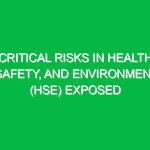Welcome to Today’s Toolbox Talk
Hello, team! Thank you for gathering here today. Our focus for this Toolbox Talk is on two crucial concepts that significantly impact our Health, Safety, and Environment (HSE) practices: Severity and Frequency. Understanding these terms and their implications can help us create a safer working environment for everyone. Let’s dive in!
What Do We Mean by Severity and Frequency?
Before we explore how Severity and Frequency affect our daily operations, let’s clarify what these terms mean.
- Severity: This refers to the potential consequences of an incident. In the HSE context, it describes how serious the outcome of an accident or near-miss could be. For example, a slip and fall that results in a minor bruise has lower severity than one that leads to a broken leg.
- Frequency: This term indicates how often an incident occurs. It can be measured over a specific time period or within a certain activity. For instance, if a particular task has frequent near-misses, it signals a need to address underlying Safety concerns.
Understanding these terms is vital because they guide our approach to risk management and Safety protocols. A high-severity incident may require immediate action to prevent recurrence, while a high-frequency issue might indicate systemic problems that need addressing.
The Importance of Severity and Frequency in Workplace Safety
Now that we have defined Severity and Frequency, let’s discuss why they are essential in maintaining a safe workplace.
Risk Assessment and Management
Effective risk assessment relies heavily on understanding Severity and Frequency. By evaluating both, we can prioritize risks and allocate resources effectively. For example, if we identify a task with high severity and high frequency of incidents, it becomes a priority for intervention.
Preventing Accidents
By analyzing past incidents based on their severity and frequency, we can implement targeted Safety Measures. Let’s take a real-life scenario: if we notice that a specific piece of equipment has caused several minor injuries (high frequency) but one major injury (high severity), we can focus on Training employees on its proper use and Maintenance to mitigate future risks.
Compliance with Regulations
Many safety regulations require companies to assess and manage risks based on Severity and Frequency. Compliance not only helps avoid legal issues, but it also fosters a culture of safety within the organization. Remember, maintaining compliance is our responsibility as employees, and understanding these concepts aids us in that effort.
Identifying Hazards Related to Severity and Frequency
To effectively manage risks, we need to identify potential Hazards that can lead to incidents. Here are some common categories:
- Physical Hazards: These include slips, trips, falls, machinery accidents, and more. If we frequently see slips in a wet area (high frequency), we need to assess the severity of potential injuries that could occur.
- Chemical Hazards: Exposure to hazardous materials can lead to severe health issues. If we regularly handle chemicals, understanding both the frequency of exposure and the severity of potential health impacts is critical.
- Ergonomic Hazards: Repetitive motions or improper lifting can lead to musculoskeletal disorders. If we notice high frequency in these injuries, we must consider the severity of their long-term Effects.
Real-Life Example: Slip and Fall Incidents
Consider a situation where we have several slip and fall incidents in the warehouse. If the severity ranges from minor bruises to severe fractures, and the frequency is high, we need to take action. This might include improving housekeeping practices, enhancing lighting, or providing slip-resistant footwear.
Actionable Strategies for Managing Severity and Frequency
Now that we understand the implications of Severity and Frequency, let’s discuss some actionable strategies we can implement:
Conduct Regular Risk Assessments
Regularly assessing the workplace for hazards allows us to identify areas that may lead to high-severity and high-frequency incidents. Ensure that risk assessments are documented and communicated to all employees.
Implement Safety Training Programs
Training is crucial in raising awareness about risks associated with Severity and Frequency. Conduct regular training sessions focusing on specific hazards identified during risk assessments. For example, if lifting injuries are common, provide training on proper lifting techniques.
Encourage Reporting and Open Communication
Encouraging employees to report near misses and unsafe conditions promotes a culture of safety. When we understand the frequency of near misses, we can take proactive measures to address them before they result in severe incidents.
Utilize Incident Analysis
After any incident, conduct a thorough analysis to determine its severity and frequency. Identify root causes and implement corrective actions. For instance, if a severe injury occurs due to equipment failure, investigate the frequency of maintenance checks and improve the schedule.
Creating a Safe Work Environment Together
As we wrap up this Toolbox Talk, remember that safety is a collective responsibility. By understanding and applying the principles of Severity and Frequency, we can work together to minimize risks and enhance our Workplace Safety. Here are a few questions to encourage discussion:
- Can anyone share an example of a situation where understanding Severity and Frequency helped prevent an accident?
- What Safety Measures do you think we can implement to reduce high-frequency incidents in our work area?
- How can we improve our communication about potential hazards?
Your input is valuable, and I encourage everyone to speak up during our discussions. Remember, we all play a role in maintaining a safe environment.
Regulations and Standards
Compliance with safety regulations such as OSHA (Occupational Safety and Health Administration) standards is essential. These regulations often emphasize the importance of assessing risks based on Severity and Frequency. Understanding these requirements not only ensures safety but also protects the company from legal repercussions.
Conclusion
In conclusion, today we’ve explored the critical concepts of Severity and Frequency within the HSE framework. By understanding these principles, we can proactively manage risks, prevent accidents, and promote a culture of safety in our workplace. Thank you for your attention and commitment to maintaining a safe working environment. Let’s continue to support each other and prioritize safety in everything we do.


